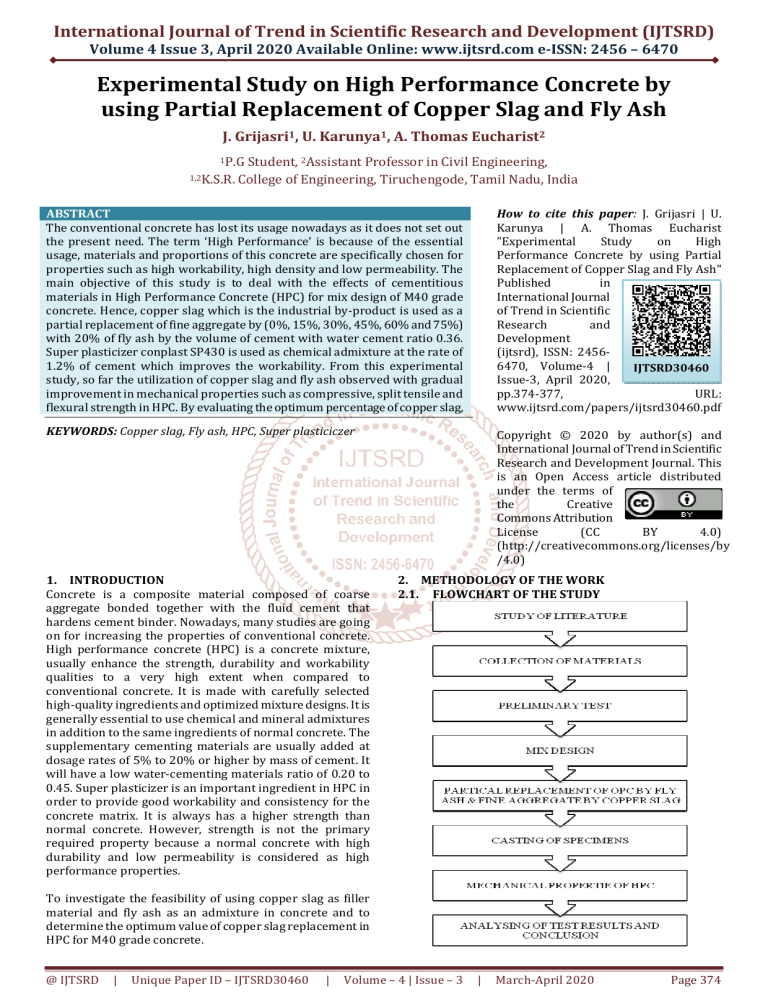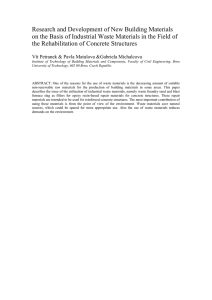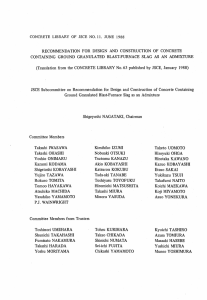
International Journal of Trend in Scientific Research and Development (IJTSRD)
Volume 4 Issue 3, April 2020 Available Online: www.ijtsrd.com e-ISSN: 2456 – 6470
Experimental Study on High Performance Concrete by
using Partial Replacement of Copper Slag and Fly Ash
J. Grijasri1, U. Karunya1, A. Thomas Eucharist2
1P.G
Student, 2Assistant Professor in Civil Engineering,
1,2K.S.R. College of Engineering, Tiruchengode, Tamil Nadu, India
ABSTRACT
The conventional concrete has lost its usage nowadays as it does not set out
the present need. The term ‘High Performance’ is because of the essential
usage, materials and proportions of this concrete are specifically chosen for
properties such as high workability, high density and low permeability. The
main objective of this study is to deal with the effects of cementitious
materials in High Performance Concrete (HPC) for mix design of M40 grade
concrete. Hence, copper slag which is the industrial by-product is used as a
partial replacement of fine aggregate by (0%, 15%, 30%, 45%, 60% and 75%)
with 20% of fly ash by the volume of cement with water cement ratio 0.36.
Super plasticizer conplast SP430 is used as chemical admixture at the rate of
1.2% of cement which improves the workability. From this experimental
study, so far the utilization of copper slag and fly ash observed with gradual
improvement in mechanical properties such as compressive, split tensile and
flexural strength in HPC. By evaluating the optimum percentage of copper slag,
How to cite this paper: J. Grijasri | U.
Karunya | A. Thomas Eucharist
"Experimental
Study
on
High
Performance Concrete by using Partial
Replacement of Copper Slag and Fly Ash"
Published
in
International Journal
of Trend in Scientific
Research
and
Development
(ijtsrd), ISSN: 24566470, Volume-4 |
IJTSRD30460
Issue-3, April 2020,
pp.374-377,
URL:
www.ijtsrd.com/papers/ijtsrd30460.pdf
KEYWORDS: Copper slag, Fly ash, HPC, Super plasticiczer
Copyright © 2020 by author(s) and
International Journal of Trend in Scientific
Research and Development Journal. This
is an Open Access article distributed
under the terms of
the
Creative
Commons Attribution
License
(CC
BY
4.0)
(http://creativecommons.org/licenses/by
/4.0)
1. INTRODUCTION
Concrete is a composite material composed of coarse
aggregate bonded together with the fluid cement that
hardens cement binder. Nowadays, many studies are going
on for increasing the properties of conventional concrete.
High performance concrete (HPC) is a concrete mixture,
usually enhance the strength, durability and workability
qualities to a very high extent when compared to
conventional concrete. It is made with carefully selected
high-quality ingredients and optimized mixture designs. It is
generally essential to use chemical and mineral admixtures
in addition to the same ingredients of normal concrete. The
supplementary cementing materials are usually added at
dosage rates of 5% to 20% or higher by mass of cement. It
will have a low water-cementing materials ratio of 0.20 to
0.45. Super plasticizer is an important ingredient in HPC in
order to provide good workability and consistency for the
concrete matrix. It is always has a higher strength than
normal concrete. However, strength is not the primary
required property because a normal concrete with high
durability and low permeability is considered as high
performance properties.
2. METHODOLOGY OF THE WORK
2.1. FLOWCHART OF THE STUDY
To investigate the feasibility of using copper slag as filler
material and fly ash as an admixture in concrete and to
determine the optimum value of copper slag replacement in
HPC for M40 grade concrete.
@ IJTSRD
|
Unique Paper ID – IJTSRD30460
|
Volume – 4 | Issue – 3
|
March-April 2020
Page 374
International Journal of Trend in Scientific Research and Development (IJTSRD) @ www.ijtsrd.com eISSN: 2456-6470
Table: 1 Physical & Chemical properties of Copper slag
Parameter
Value
Type
Air cooled
Grain size
Multifaceted
Specific gravity
3.41
SiO2
33 – 35
Fe2O3
40 – 44
Al2O3
4.0 -6.0
Mgo
1–2
Cao
0.8 – 1.5
3. MATERIAL COLLECTION
3.5. FLY ASH
Fly ash is a fine-grained, Powderly particulate pozzolonic in
nature produced from thermal power plant. The burning of
harder and bituminous coal typically produces Class F fly
ash. It is used in this study is collected from Neyveli Lignite
Corporation (NLC). The Physical properties and chemical
properties of fly ash are given in the Table.
3.1. CEMENT
The experiment uses Ordinary Portland Cement (OPC) 53
Grade conforming to IS 12269 is used for casting concrete.
Specific gravity is 3.15, fineness and consistency is 1.4% and
32 %.The tests of cement should be conducted as per IS 4031
(Part 5).
3.2. FINE AGGREGATE
It is natural sand or crushed stone with most particles
through 9.5mm sieve. Specific gravity is 2.6 and fineness
modulus was found out Zone (II) is 2.66. The tests are
carried out as per IS 2386 (Part 3).
3.3. OARSE AGGREGATE
It consists of naturally occurring stones. The size of coarse
aggregate used was 20mm.Specific gravity is 2.65 and water
absorption is 1%. The tests are carried out as per IS 3831970.
3.4. COPPER SLAG
Copper slag is an irregular, black, glassy and granular in
nature which is by-product obtained during the
metallurgical operations in furnaces of copper industries.
The physical properties are similar to natural sand. Al2O3,
SiO2, Fe2O3, about major therefore have good potential to
produce high quality Pozzolonic content. Copper slag. used
in this project is collected from ASTRAA Chemicals, Chennai.
The Physical properties and chemical properties of copper
slag are given in the Table
Fig.2 Fly Ash
Table2 : Physical &Chemical Properties of Fly ash
Parameter
Value
Specific gravity
2.1
Fineness modulus 2.16
SiO2
63.11
Al2O3
19.58
CaO
17.13
Fe2O3
5.03
L.O.I
1.55
4. EXPERIMENTAL DETAILS Mix design and
Identification
In this study, M40 grade of concrete for HPC is designed in
accordance with the guidelines of code book IS 10262:1982.
The mix ratio is 1: 1.18: 2.4 (C: FA: CA) and w/c ratio is
0.36 is adopted. Copper slag is added at varying percentages
of 0%, 15%, 30%, 45%, 60% and 75% by replacing fine
aggregate (FA) with 20% of Fly ash by the volume of cement.
Each mix is denoted by M, in which M1 represents the
conventional mix and from M2 to M6, cement is replaced by
20% of fly ash and FA by 0-75% of CS.
Table3: Mix Proportion
Fig. 1 Copper Slag
@ IJTSRD
|
Unique Paper ID – IJTSRD30460
|
Volume – 4 | Issue – 3
|
March-April 2020
Page 375
International Journal of Trend in Scientific Research and Development (IJTSRD) @ www.ijtsrd.com eISSN: 2456-6470
4.1. CASTING OF SPECIMEN
The moulds for the specimen must be made of cast iron or
steel. For most of the works Cubical moulds of size 150mm x
150mm x 150mm, Cylinder 300mm height and 150mm
diameter and then flexural 100x100x500mm are commonly
used.
Fig.4 Compressive Strength Results
Fig.3 Casting Of Specimen
Table: 5 Split Tensile Strength Results
4.2. TESTING OF SPECIMEN
It has been carried out to the specimens to ascertain the
mechanical related properties deals with Compression and
Split tensile strength of concrete specimens are done to find,
the most efficient combination of copper slag and fly ash
with chemical admixture dosage of 5.72 kg/m3.
Fig. 5 Split tensile strength results
Fig4. Compressive Strength testing of Cube
5. RESULTS
Table: 4 Compressive Strength Results
@ IJTSRD
|
Unique Paper ID – IJTSRD30460
|
6. CONCLUSION
1. Copper Slag is considered as a waste material which
could have a promising future in construction industry
as partial or full replacement of either cement or
aggregates.
2. Through this study it is found that, there is improvement
in strength of HPC compared to conventional concrete
due to presence of copper slag, fly ash and chemical
admixture there is an increase in the strength of
concrete.
3. The strength of the specimens after 7 and 28 days, the
mix M4 attained compressive strength of 40 and 52.2
N/mm2 and then split tensile strength of 3.7 and 4.4
N/mm2 split tensile strength.
4. While comparing the results with conventional concrete
the optimum percentage obtained in 45% copper slag
and 20% fly ash with Super plasticizer dosage of
5.72 kg/m3.
Volume – 4 | Issue – 3
|
March-April 2020
Page 376
International Journal of Trend in Scientific Research and Development (IJTSRD) @ www.ijtsrd.com eISSN: 2456-6470
REFERENCE
[1] Naganur, B. A. Effect of Copper Slag as a Partial
Replacement of Fine Aggregate on the Properties of
Cement Concrete. International Journal of Research
(IJR) Vol-1, Issue-8, September 2014.
[2] Rose, D. A. Performance of Copper Slag on Strength and
Durability Properties as Partial Replacement of Fine
Aggregate in Concrete. International Journal of
Emerging Technology and Advanced Engineering, 5(1),
434-437, 2015.
[3] Srinivasu, K. A study on compressive strength
properties and effects of copper slag as partial
replacement of fine aggregate in concrete. ELK Asia
Pacific Journals.
[4] Zerdi, T. A. Experimental Investigation on Properties of
Concrete by Replacement Copper Slag for Fine
Aggregate. Global journal for research analysis, 5(5),
67-69, 2016.
[6] Patil, M. V. Performance of Copper Slag as Sand
Replacement in Concrete. International Journal of
Applied Engineering Research, 11(6),4349-4353, 2016.
[7] Arivalagan.S. (2013). Experimental Study on the
Flexural Behavior of Reinforced Concrete Beams as
Replacement of Copper Slag as Fine Aggregate. Journal
of Civil Engineering and Urbanism, 3(4), .176-182
[8] M. Maheswari, M. (2016). Mechanical and Durability
Properties of RC Beams Using Copper Slag as Fine
Aggregate in Concrete. International Research Journal
of Engineering and Technology, 3(3)
[9] Madhavi, T. C. Effect of Copper Slag on the Mechanical
Strengths of Concrete. International Journal of
ChemTech Research, 8(12), 442-449, 2015.
[10] Nataraja, M. C. Concrete mix design using copper slag
as fine aggregate. International journal of civil
engineering, 5(9), 90-99, 2014.
[5] Singh, H. Use of copper slag as fine aggregate - A case
study. International journal of innovations in
engineering research and technology, 2(5), 1-7, 2015.
@ IJTSRD
|
Unique Paper ID – IJTSRD30460
|
Volume – 4 | Issue – 3
|
March-April 2020
Page 377


